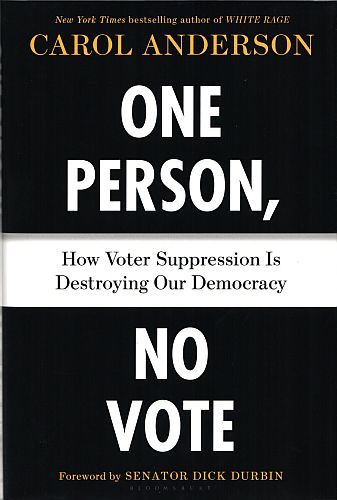

| ONE PERSON, NO VOTE How Voter Suppression Is Destroying Our Democracy Carol Anderson Senator Dick Durbin (Fwd.) New York: Bloomsbury Publishing, September 2018 |
Rating: 5.0 High |
|||
| ISBN-13: 978-1-63557-137-0 | ||||
| ISBN-10: 1-63557-137-5 | 271pp. | HC | $27.00 | |
Efforts to prevent minority citizens from voting — Blacks especially, but also Latinos and Asians — have been widespread and persistent in America, despite the Constitution and the Fifteenth Amendment.
"The determination to wipe out the black vote ensnared whites as well, however. Though, for many of those in power, that was just fine. One Mississippi politician remarked that his state had to disenfranchise 'the ignorant and vicious white,' too, so that the electorate was 'confined to those, and to those alone, who are qualified by intelligence and character for the proper and patriotic exercise of this great franchise.' The resulting 'voter mortality rate' was staggering. Throughout the South after the widespread adoption of the Mississippi Plan, voter turnout plummeted to less than half of age-eligible whites, after it had peaked in 1896 at 79.6 percent. In Texas, for example, only 27 percent of age-eligible whites voted in the 1956 election (the national rate was 60 percent). The decline was even more dramatic in the Magnolia State. In the late nineteenth century, Mississippi's voter turnout was close to 70 percent; 'by the early twentieth century it scraped near to 15 percent.' " "While there was a steady erosion of white voters, the collapse of black voter turnout was precipitous. In Louisiana, where 'more than 130,000 blacks had been registered to vote in 1896, the figure dropped to a bleak 1,342 by 1904.' African American registered voters in Alabama plunged from 180,000 to fewer than 3,000 in just three years. As historian C. Vann Woodward concluded, 'The restrictions imposed by these devices [in the Mississippi Plan] were enormously effective in decimating the Negro vote.' Indeed, by 1940, shortly before the United States entered the war against the Nazis, only 3 percent of age-eligible blacks were registered to vote in the South." – Page 4 |
The arcane and often ridiculous questions of the literacy tests,1 coupled with the poll tax and the complicated requirements for paying it and getting registered, formed an almost insurmountable barrier. Intimidation factored in as well; in many communities, the county sheriff was made the gatekeeper. Finally, many black sharecroppers simply could not afford the poll tax. Ms. Anderson details these carefully crafted obstacles in Chapter 1. Some of them persisted in places (Texas) as late as 1963.
There were pitched battles over the larger question of Blacks' enfranchisement. One common ploy to prevent this was the "white primary." If only whites got to choose the candidates, Blacks cold be welcome to vote in the fall election because they could make no difference then. Texas was the most blatant, actually forbidding black primary votes by statute and directly contravening the Fifteenth Amendment. Most states, however, tried to dodge by declaring the primary election a private affair not under state control: a thin subterfuge. Things finally came to a head on the Edmund Pettus Bridge in 1965. The result was the Voting Rights Act of 1965 — a law with teeth. Unlike its predecessors, it prevented voter disenfranchisement rather than trying to punish it after the fact. The heart of it was Section 5. That was gutted in 2013 under the specious argument that it was no longer needed.
Of course there was pushback, by methods both direct and devious. The very next year, South Carolina challenged the VRA on the basis that it interfered with state sovereignty. The Supreme Court reaffirmed the VRA 8:1. Virginia and Mississippi tried a more subtle approach: they merely wanted to make minor changes in the interest of efficiency. These changes required illiterate voters to hand-write the names of candidates on the ballot; those who used stickers, previously approved, had their ballots thrown out. Virginia went further. Taking a long-term view, it shut down public schools and funneled its education funds into all-white private academies. Then it changed state laws to bar illiterates from voting.
The book details a host of tactics designed to impede blacks from voting. It is an essential read for anyone who wants to understand how racial bigotry and segregationist policies have never ended in the putative Land of the Free. It has endnotes and a good index, and also a list of resources for those wanting to learn more. I give it full marks and rate it a keeper.

 To contact Chris Winter, send email to this address.
To contact Chris Winter, send email to this address.